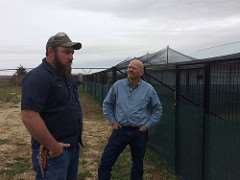
Every so often the hushed sound of scurrying birds is punctuated by a piercing call: the short, two-note sound a pheasant rooster makes when it’s flushed from the ground. Here is where Kansas State University animal science researchers and students are looking for the best ways to raise poultry efficiently, humanely and profitably.
And now that poultry farm is also home to a new research facility focused on game birds such as Ring-necked pheasant, thanks to Scott Beyer, K-State associate professor, and C.J. Delfelder, a graduate student. Delfelder is working on a master’s degree in avian nutrition management with a focus on game birds.
Kansas is known for its cattle, wheat and grain sorghum, but upland game-bird hunting, particularly pheasant and quail, provide an economic boost to communities large and small across the state. Private landowners and hunting-lodge owners alike often turn to game-bird breeders to replenish bird numbers on their property.
“We’re looking to help game-bird breeders grow healthy birds in the most cost-effective way,” Beyer said of the new program. “To our knowledge, this is unique. No one else is doing this.”
Most bird research occurring at universities, he said, is focused on more conventional turkey, chicken and egg production. Little research has been done on the nutritional needs of game birds, including the best feed ingredients and bird health.
Kansas is one of the top three grow-and-release game-bird producing states. The pheasant are typically house brooded, then moved to large flight pens made of light netting where the birds finish growing and learn to fly and forage.
Economic data at the state level is hard to come by, but according to a national U.S. Census report on hunting, fishing and watching wildlife issued in 2012, nearly all hunters hunted in the state where they lived and 14 percent hunted in other states. Overall, hunters across the country spent $33.7 billion on hunting trips, equipment and other items in 2011 – an average of $2,465 per hunter.
The just-launched K-State program will focus on the nutritional needs of game birds, initially pheasant.
“Everybody who comes to hunt in Kansas wants pheasant,” said Beyer, who is a poultry specialist with K-State Research and Extension. The bobwhite quail and chukar partridge are also popular.
“Some breeders in Kansas have created crosses. They’re still pheasants but are smaller and faster off the ground,” Beyer said, citing the Kansas Blueback as an example.
“A lot of what we know (about game birds) comes from what we’ve learned about chickens,” he said, adding that there are fundamental differences. Unlike chickens, when pheasant or quail escape, they fly off. That makes construction of the pens even more important. Not everything built for poultry works for game birds. The pens also must be predator-proof.
People in the business of growing game birds sell chicks or adult birds to a variety of buyers, from a conservation-minded farmer or landowner who wants to keep bird populations up on his property to lodges that offer guided hunting, gourmet meals and corporate retreat facilities.
Beyer credits grad student Delfelder for his perseverance to complete the research pen construction.
Delfelder, who grew up in Meriden, Kansas, said he’s always been interested in game-bird production. After finishing a bachelor’s degree at K-State in 2013, he worked in an internship for a game-bird producer. Upon returning to K-State to start a master’s degree, he agreed to work full time managing the poultry research unit while also finding time to turn a then-unused older building into a game-bird research facility.
Beyer approached K-State Associate Dean of Academic Programs Don Boggs and Animal Science Department Head Ken Odde about initial funding for the project, and industry partners have donated materials and money.
“We did everything from using (lumber yard discount) coupons to attending auctions. We salvaged and saved,” said Beyer in describing the three-year process to renovate the building, which included adding a new roof, pens, plumbing, and indoor and outdoor netting. The birds can move from indoor to outdoor pens through a special sliding door system that Delfelder designed.
Don Montgomery of Blue Hill Gamebirds in Tipton, Kansas, donated 100 pheasant hens and six roosters to K-State in late February to get things started. The hens are already laying eggs.
The game bird building is on the same property as the university’s other poultry facilities, but human contact with the birds is kept to a minimum to keep them as wild as possible. “We don’t want them to get too used to being around humans,” Beyer said. “We want them to fly off when they’re released.”
Once he’s finished his master’s degree, Delfelder said he intends to work in game-bird production in one capacity or another.
Beyer said he hopes the project will attract extramural funding from the U.S. Department of Agriculture or other agencies.
Source:k-state.edu